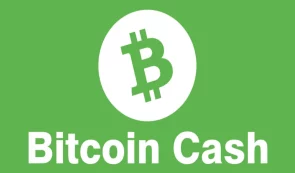What is Bitcoin Cash
Bitcoin Cash (BCH) is a cryptocurrency that is derived from a hard fork of the Bitcoin blockchain. BCH’s mission is to be a better payment system than Bitcoin by providing fast and cheap transactions. Unlike Bitcoin, BCH processes transactions extremely fast, with minimal transfer fees.
Due to the scalability issues of Bitcoin, the world’s first cryptocurrency, a solution to slow transactions emerged in 2017 in the form of Bitcoin Cash. At block height 478,558, the Bitcoin network did a hard fork, making all previous blocks invalid on the new network.
In other words, after this Bitcoin update, two networks emerged – one that continued on the same path and another that created its own. The split in question came about after disagreements between miners and developers on the Bitcoin network because much of the community believed that the blockchain project was designed to serve as a method for digital transactions, not a store of value.
Everyone who held BTC during the hard fork received the same amount of tokens in BCH.
History of Bitcoin Cash
On July 21, 2017, Bitcoin miners implemented a software upgrade called Bitcoin Improvement Proposal (BIP) 91, meaning the Segregated Witness upgrade would activate in block 477,120. Segwit controversially would have enabled second-party Bitcoin solutions, such as the Lightning Network. The management of the nodes (nodes themselves) was a key difference of opinion for Bitcoin users.
Supporters of Bitcoin wanted the blocks to be small so that nodes could be managed with fewer resources. In contrast, some supporters of large blocks found it acceptable that universities, private companies, and NGOs could only manage (due to the large size of the blocks) nodes.
Roger Ver, an early Bitcoin investor, was among the first to integrate Bitcoin payments on his web page. Since then, the popular personality in the space has organized a number of events and meetups related to the technology.
Ver has been one of the fiercest advocates of Bitcoin Cash as he claims that BCH is much “more usable” compared to the flagship cryptocurrency thanks to the speed of transactions.
Bitcoin Cash later implemented two forks of its own, Bitcoin Cash ABC (BCHA) and Bitcoin SV (BSV).
Bitcoin Cash ABC
Bitcoin Cash ABC uses the original BCH client and has undergone various iterations on the blockchain, including the canonical transaction ordering method (CTOR), which aims to improve on the existing topological transaction ordering method (TTOR) by rearranging transactions and placing them in a specific order to make Bitcoin mining more convenient for rewarding blocks.
Bitcoin SV
Bitcoin SV – Satoshi Vision – is a fork created by Craig Wright, one of the individuals who claim to be Satoshi Nakamoto, the creator of the original Bitcoin. Wright views Bitcoin SV as a platform for financial transactions and opposes using smart contracts in the Bitcoin SV blockchain. The BSV cryptocurrency aims to preserve the stability and scalability potential of the original BTC algorithm. Many in the crypto community view Craig Wright as a charlatan trying to exploit Satoshi’s pseudonymity for money and power.
How does Bitcoin Cash work?
Bitcoin Cash is a decentralized, open-source network that, like Bitcoin, uses a consensus proof-of-work (PoW) mechanism to mine new tokens and approve transactions. Miners earn BCH as a reward for their work.
Bitcoin Cash also has a cap on the total supply that will ever enter the circulation of 21 million tokens.
As previously mentioned, Bitcoin Cash runs faster and has lower transaction fees than Bitcoin, thanks to the larger block size.
In a stress test in September 2018, BCH processed 25,000 transactions per block, far exceeding BTC’s average of 2,759. The stress test was intended to prove BCH’s ability to scale, ultimately handling $2.1 million in transactions in 24 hours without raising token transfer fees.
The Bitcoin Cash network also supports smart contracts and decentralized applications.
Bitcoin Cash vs. Bitcoin
Bitcoin Cash uses the same hashing algorithm as its predecessor, SHA-256.
However, Bitcoin Cash uses Emergency Difficulty Adjustment (EDA) to dynamically adapt the complexity of encryption to the number of miners available on the network. In this way, on-chain computations must always continue and ensure the stability of the blockchain’s operation.
In the early years of cryptocurrencies, blocks could store up to 36 MB (megabytes) of transaction data. However, Satoshi Nakamoto reduced Bitcoin’s capacity and allowed blocks to store 1 MB of data in order to minimize cyber threats and spam.
The 1 MB limit is still in effect today. However, as trading volume increases, BTC blocks are quickly filling the 1 MB limit. The growing number of transactions increases the burden on BTC miners, who are incentivized to generate new blocks regardless of the data limit.
BCH maintains a data transaction limit of 32 MB to allow for more tps (transactions per second). However, increasing the size and capacity of blocks leads to other problems, such as the network becoming more centralized and having security issues.
Since fewer nodes can handle the number of transactions flowing through the blockchain, larger blocks (and smaller numbers) compromise decentralization.
Bitcoin Cash has also been increasing the block size on the blockchain throughout its history – in 2018, the block size was 8 MB. In June 2022, the block size increased again to 32 MB.
SegWit
The main goal of SegWit is to improve the throughput of transactions on the blockchain network.
Essentially, the SegWit feature reduces the burden of transactions in a block on the blockchain by splitting the transaction into two parts; effectively increasing the number of transactions that can be included in a block of the same size.
The first part of the transaction contains the wallet addresses of the sender and receiver, and the second part contains the “witness data” containing the transaction signatures. SegWit removes the “witness data” from the main block, significantly reducing the transactions’ size. Transactions, therefore, require less space, allowing more transactions per block and significantly increasing the Bitcoin network’s capacity.
Since the signature has been moved from the transaction data to the separated witness data, changing the transaction identifier is no longer possible. SegWit is, therefore, a solution to the problem of transaction forgery.
Broadly speaking, SegWit represents the first step towards scalability for Bitcoin and several other major cryptocurrency networks.


